Camborne Met Office: Tracking the Weather from Cornwall Since 1875
Tucked away in the far southwestern corner of the UK, beyond the surfboards of Newquay and the pasties of Penzance, lies a quietly heroic outpost of British weather watching: Camborne Met Office. It might not make the bucket list for your summer holidays, but when it comes to tracking the skies, few places have been at it longer — or with such dedication.

Camborne is where the weather gets real. Not just a local forecast or a passing mention on the news — this is where balloons are launched, clouds are scrutinised, and data is diligently scribbled (or, more recently, uploaded). It’s where the swirling chaos of Atlantic weather first makes landfall and where, crucially, someone’s keeping an eye on it.
A Bit of Background (Because Every Met Station Has a Story)
The Camborne Met Office station has been collecting weather observations since 1875 — that’s Victorian Britain, in case you’re wondering. Back when the only real way to know if rain was coming was to look at your bones or stare ominously at the horizon. Since then, Camborne has grown from simple readings with thermometers and barometers to become one of the UK’s key upper air observation stations.
That means it’s one of the few places in the country that still launches weather balloons (yes, really). Every day, a high-flying hydrogen balloon is sent drifting into the upper atmosphere, carrying a little gadget called a radiosonde. It measures pressure, temperature, humidity, and wind as it climbs through the troposphere — sometimes reaching heights of over 30km, or roughly 100,000 feet.
These readings are crucial for global weather models, helping predict everything from weekend rain to transatlantic storms. It’s scientific work with far-reaching impact, and it happens daily from a quiet field in Cornwall.

Why Camborne?
Great question. The location is no accident. Cornwall’s far west coast gives it a clear path to incoming Atlantic systems. That’s a big deal when you’re trying to measure conditions before they hit the rest of the UK. The open skies, lack of high-rise buildings, and relatively unspoiled air (aside from the occasional whiff of clotted cream) make it ideal for both surface and upper-atmosphere observations.
Highlights Through the Years
- 1979: Camborne was one of the first stations to detect the dramatic drop in ozone levels, part of the research that would eventually highlight the infamous ozone hole.
- 1987: During the Great Storm, Camborne’s readings fed into the understanding (and post-mortem) of one of the UK’s most infamous forecasting blunders.
- Present day: Camborne plays a role in tracking long-term climate trends, giving us insights into everything from rising temperatures to shifting wind patterns. It’s not just about the next five-day forecast — it’s about understanding the planet.
Weather Watching, Cornish Style
If you ever fancy a field trip that’s off the beaten path (and features fewer queues than the Eden Project), Camborne’s Met Office station has a certain rugged charm. While it’s not exactly a theme park, just knowing that this site sends balloons into space daily makes it feel a little more cosmic.

With the help of historic weather graphs (which you’ll find below), you can trace Camborne’s role in documenting everything from blustery winters to sun-drenched summers. It’s a quiet testament to Cornwall’s place in the ever-whirling narrative of British weather.
Final Forecast
So, yes — Camborne Met Office might not be where you’d expect to find excitement. But it’s a place where curiosity meets climate, and science meets the sky. It’s also proof that you don’t need to be flashy to be vital.
Whether you’re a weather buff, a local historian, or just someone who appreciates the British obsession with talking about the rain, Camborne’s little station on the edge of the Atlantic has earned its stripes — one gust, drizzle, and high-pressure system at a time.
Above: Camborne Met Office, Cornwall – where the balloons go up and the data comes down.
Scroll back up to revisit Camborne's meteorological legacy, or stay tuned for more weather nostalgia coming soon and don't forget you can download historic data for Camborne Met Office at:
https://uk-historic-weather.co.uk/camborne-weather-data
or visualise historical data for Camborne Met Office using our chart tool:
https://uk-historic-weather.co.uk/camborne-weather-chart